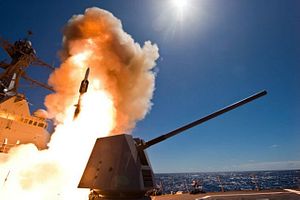Fans of Tom Clancy’s novel Red Storm Rising may find the news hard to believe, but the Oliver Hazard-Perry-class guided-missile frigate USS Reuben James was sunk off Hawaii in January.
The USS Reuben James, which was also featured in the filmed version of Clancy’s The Hunt For Red October, went down after being hit by an anti-surface warfare variant of the Raytheon Standard Missile-6 as part of a test of the U.S. Navy’s new “distributed lethality” warfighting concept. The ship had already been decommissioned in 2013.
The vertically launched supersonic SM-6 missile, originally designed to intercept incoming aircraft and cruise missiles, was fired from the Arleigh Burke-class guided missile destroyer USS John Paul Jones on January 18, hitting the USS James Reuben anchored at the U.S. Navy’s Pacific Missile Range Facility off the coast of Hawaii.
“The test was a demonstration of the U.S. Navy’s concept of ‘distributed lethality,’ employing ships in dispersed formations to increase the offensive might of the surface force and enabling future options for the joint force commander,” according to a Raytheon press release.
“Distributed lethality is about having such overwhelming offensive superiority that no potential threat would consider attacking. And if for some reason they did attack, they would lose decisively and rapidly,” said former U.S. Navy Surface Warfare Officer William J. Parker III, one of the minds behind the distributed lethality concept, in an interview with The Diplomat.
Part of the Navy’s distributed lethality concept has been to modify existing weapon systems and employ them in missions for which they were not originally designed. It was obviously with that in mind that U.S. Secretary of Defense Ashton Carter told reporters in February 2016: “We are going to create a brand-new capability. We’re modifying the SM-6 so that in addition to missile defense, it can also target enemy ships at sea at very long ranges.”
The Mach 3.5+ SM-6 has an effective range of approximately 200 (some say 250) nautical miles (around 370 kilometers) outranging the U.S. Navy’s other major anti-surface weapon, the Boeing RGM-84 Harpoon anti-surface missile. The SM-6 provides U.S. fleets with an over-the-horizon engagement capability.
Since 2013, Raytheon has delivered more than 250 SM-6 missiles to the U.S. Navy. Most standard missiles aboard the U.S. Navy’s surface ships have a surface capability. However, one of the issues with using a surface-to-air missile to attack a naval vessel is that the warhead might not be powerful enough to inflict substantial damage, despite a probable hit-to-kill capability given the SM-6 missile’s speed.
The January 2016 test could indicate that a new, more powerful warhead has been fitted on the SM-6. However, given that there was no damage control team aboard the USS Reuben James that could potentially have kept the ship afloat and operational despite being hit, it is difficult to draw any firm conclusions from the January missile test.
In May 1987, during the Iran-Iraq War, the U.S. Navy vessel USS Stark was hit by two Excocet anti-ship missiles off the Saudi Arabian coast in an attack that killed 37 sailors. However, the missiles did not sink the ship, given the quick reaction of the Stark’s damage control team.
































